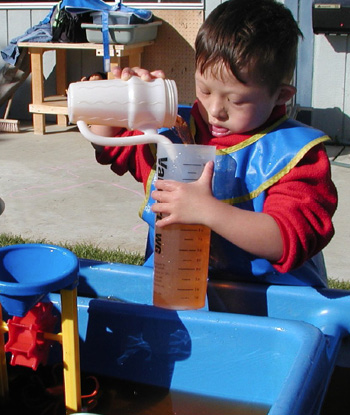"When I first started the job, it took me a while to gain the trust of leaders in the community. But over time, they were willing to help me locate families they knew who had young children with suspected disabilities. The families were worried about being stigmatized." – Disability services coordinator
This chapter describes the process of recruiting and enrolling children with disabilities or suspected delays in your program and the regulations that apply. The process Head Start managers and staff use to get eligible children in the door is described in Eligibility, Recruitment, Selection, Enrollment, and Attendance (ERSEA), 45 CFR §1302 Subpart A.
As the disability services coordinator, you play an important role in reaching out to the community to identify Head Start-eligible children with disabilities. You also ensure other staff, former Head Start parents and families, and community partners are prepared to help in this effort. Part of your job is to spread the word that Head Start programs are inclusive settings that welcome all children and offer comprehensive services.
Key Ideas
- Community and self-assessment data help programs identify families of children with disabilities and offer them access to program services.
- Collaborations with the local Child Find office, early intervention programs, and the school district can support the recruitment and enrollment process.
- A Head Start grant recipient must fill at least 10% of its total actual enrollment with children who have been deemed eligible to receive IDEA services.
- Enrollment can't be denied due to a disability or chronic health condition or its severity.
- Supports for children with disabilities are part of a program policy to decrease suspensions and eliminate expulsions.
- Recruiting and enrolling children with disabilities who represent culturally and linguistically diversity is a priority.
- Recruitment is everyone's business; staff, former and current parents and families, and community partners can be part of the effort.
How does ERSEA happen in Head Start programs?
ERSEA is how your program meets its funded enrollment. The HSPPS requirements are spelled out in 45 CFR §1302 Subpart A. They are far-reaching, starting with the mandate that a program conducts a community assessment—collecting and using data to describe the community's strengths, needs, and resources. A program must describe the number of eligible children from birth to age 5 and expectant mothers, along with their geographic location, race, ethnicity, and the languages they speak. Also, a program must collect information on the number of children with disabilities, the types of disabilities, and relevant community services and resources.
The HSPPS describe the age and income eligibility requirements and exceptions. If a program has made every effort to enroll income-eligible children and pregnant women, up to 35% of the families may be over the income limit and their incomes may be between 100–130% of the poverty line. A program needs a process for verifying eligibility, keeping records, and training staff. It must have a recruitment process to identify families with eligible children and help them enroll. A program must include specific efforts to locate and recruit children with disabilities and other vulnerable children, including children experiencing homelessness and children in foster care. Annually, a program must establish selection criteria that prioritize applicants based on community needs and other factors, including eligibility for IDEA services.
Once families meet the selection criteria, they can enroll their children in the program. After the first day of services in a center- or home-based setting, a program must track attendance to make sure children and families get support they need. Poor attendance is a serious matter, because absent children are not able to maximize their learning opportunities.
The HSPPS also address suspension and expulsion. Temporary suspension due to a child's behavior is prohibited or severely limited. Expulsion or unenrollment of a child due to the child's behavior is prohibited.
HSPPS Related to ERSEA
- Purpose, 45 CFR §1302.10
- Determining community strengths, needs, and resources, 45 CFR §1302.11
- Determining, verifying, and documenting eligibility, 45 CFR §1302.12
- Recruitment of children, 45 CFR §1302.13
- Selection process, 45 CFR §1302.14
- Enrollment, 45 CFR §1302.15
- Attendance, 45 CFR §1302.16
- Suspension and expulsion, 45 CFR §1302.17
What do you need to know about ERSEA?
As the disability services coordinator, you will want to know about the ERSEA requirements that apply to all children in Head Start programs. There are some HSPPS regulations that directly affect your work. 45 CFR §1302 Subpart A highlights the recruitment and selection of children with disabilities. Head Start programs are prohibited from excluding children based on their disability or chronic health condition or its severity. This is a strong statement in favor of inclusion. Keep in mind the income exceptions that may open program slots for children with disabilities. Also, be sure families know if your program offers family child care, a home-based program, or a partnership with child care. To meet their needs, some families may prefer an alternative to center-based care if your program offers it.
Plan for Partnerships
- Include a variety of outreach strategies for families that are hard to reach
- Provide language about suspension and expulsion so partners know how to support one another to reduce suspension and eliminate expulsion
- Specify contacts with Child Find, agencies, and other community resources
- Ensure ERSEA staff use strengths-based language to refer to children with disabilities and to describe the benefits of inclusion
- Develop recruitment materials that are culturally and linguistically responsive to families and children
What does the 10% requirement mean?
Your program develops multiple selection criteria, including prioritizing children's eligibility for IDEA services pertaining to special education or early intervention. This priority helps guarantee at least 10% enrollment of children who are deemed eligible for IDEA services, as required by the HSPPS.
In simple math terms, if the actual enrollment for your program is 400 children, then the program should have enrolled 40 children — 10% of the actual enrollment — who are eligible for services under IDEA over the course of the program year.
 Children with disabilities in Head Start and Early Head Start programs who are enrolled in child care partnership programs also count toward your grant recipient's 10% requirement. The requirement applies to the grant recipient, not to each and every center or classroom or any one program option or partner.
Children with disabilities in Head Start and Early Head Start programs who are enrolled in child care partnership programs also count toward your grant recipient's 10% requirement. The requirement applies to the grant recipient, not to each and every center or classroom or any one program option or partner.
Points to keep in mind about the 10% requirement:
- Children who have been evaluated and deemed eligible for IDEA services, regardless of whether they are receiving such services, count toward the 10% requirement.
- Children with disabilities or delays who have not been deemed eligible for IDEA services do not count toward the 10% requirement.
- Children who are waiting for an evaluation or are in the evaluation process do not count toward the 10% requirement.
- The 10% requirement is based on actual enrollment, not funded enrollment.
- If a child is deemed eligible, but the parents and families do not consent to IDEA services, the child still counts toward the 10% requirement.
Learn more about the 10% requirement for serving children with disabilities. Refer to this Information Memorandum, ACF-IM-HS-20-01 Inclusion of Children with Disabilities.
Together with other program staff, such as the family advocates, you can help parents and families understand how their child can benefit from services. Many parents and families are unfamiliar with early intervention and special education services. You might work with the education staff or home visitors to help children understand what the process of determining eligibility means for them. The staff who know the child best will find sensitive and caring ways to communicate at the child's level. These interactions are examples of the coordinated approach in action — staff with different expertise work together on behalf of children with identified or suspected disabilities and their families.
If your program has done everything possible to recruit and identify children who meet this qualification and you still don't meet the 10% requirement, then your program director needs to alert the Regional Office. If, after further discussion, the 10% requirement still can't be met, then your program director can ask for a waiver or exemption for this requirement from your Regional Office. Keep in mind that some programs exceed the 10% requirement, and you may ask for their advice about recruitment strategies.
What is your role in recruiting?
As your program begins the recruitment process, you will need to work closely with the ERSEA team. The team usually consists of the family service manager and family advocates who know the community well. Your role is pivotal in every step of the process. You want to do everything you can to help ensure your program meets its 10% requirement. Work with program management to update the community assessment; it helps identify children with disabilities or suspected delays in the service area. It also provides information about relevant services and resources in the community. You might identify gaps in the community services. Such gaps can affect your program design and staffing and open up possibilities for new partnerships.
You need to ensure all ERSEA staff know how to reach out to families of children with disabilities or suspected delays. The way staff communicate and interact with families can encourage or discourage enrollment. Are program recruiters aware of and use words and language that are respectful, supporting, and encouraging of children with disabilities and their families? Are they informed about your program's commitment to the full and effective participation of children with disabilities and their families? Help staff understand that nondiscriminatory program practices are required in the legislation cited in the HSPPS, including in Section 504 of the Rehabilitation Act and in the ADA. You may need to address this topic in staff development. As the disability services coordinator, you are key to promoting recruitment strategies that reach families of children with disabilities.
Make sure your program's outreach efforts connect with children's adult caregivers. They are diverse and can include step-parents, grandparents, aunts, uncles, or foster parents. Families can be biological or nonbiological, chosen or circumstantial. They are connected through cultures, languages, traditions, shared experiences, emotional commitment, and mutual support.
Reach out to fathers of young children. Find out where they are likely to gather in your community (e.g., a barber shop, a recreation center, the lunchroom of a local employer). Plan a visit and distribute father-friendly materials about your program.
Fathers, grandparents, step-parents, and foster parents, as well as mothers, can enroll children in Head Start programs!
As always, it is important for you to keep records of recruitment efforts. Information on the selection criteria, enrollment, and attendance of children with disabilities is useful. See Appendix B for an ERSEA worksheet and action plan.
Reach out to the Child Find coordinator in your district or county. Child Find is a legal requirement under IDEA that mandates states to locate, identify, and evaluate children who have disabilities and who may be entitled to early intervention or special education services. Child Find is often the entry point for families whose young children have suspected delays or disabilities.
You may also be able to identify children eligible for Head Start services based on the following.
- The Early and Periodic Screening, Diagnostic, and Treatment (EPSDT) benefit that provides comprehensive and preventive healthcare services for children under age 21 who are enrolled in Medicaid. EPSDT is key to ensuring children and adolescents receive appropriate preventive, dental, mental health, developmental, and specialty services. Your program's health manager is likely to receive this referral.
- The Child Abuse Prevention and Treatment Act (CAPTA) requires staff to refer children under age 3 who are involved in a case of abuse or neglect to the Part C lead agency for a screening.
- Referrals from your community partners, such as the local Easter Seal agency and the children's hospital.
- Referrals from families' dental and medical homes; these contacts may be in touch with the health manager.
When recruiting families, it's okay to brag about the Head Start program as a placement option. It's an inclusive environment that provides comprehensive services for all children and support for families. Work with your community partners and local healthcare providers, because they often assist families through an evaluation process and help them find appropriate inclusive placements. You want to be sure they know about Head Start programs' comprehensive services.
Get your elevator speech ready! Work with your management systems, including fiscal and communication, to provide information about Head Start programs' inclusive policies and practices. You can spread the word via print and social media. As much as possible, communicate in families' home languages during your outreach efforts.
Attendance Matters
Once families enroll, pay attention to the attendance data. For all Head Start children, attendance matters. When children are absent, they miss out on learning opportunities and socialization experiences. Be aware that some children with disabilities have related health issues that can affect their attendance. Working with the management team, the HSAC, and early intervention and special education partners, you can promote their participation.
If children with disabilities exhibit behaviors that challenge adults and affect their ability to participate, take steps to re-engage them. Suspension should rarely be an option, and expulsion should never be considered. The regulations require engaging a mental health consultant; considering support services under Section 504; and consulting with the child's parents, family, and teacher or home visitor to help address the concerns. You will likely take the lead at this point. Tell families and staff that the goal is to facilitate the child's safe participation in the program or, in rare cases, to find an alternative placement.
Tips to Boost ERSEA Efforts
- Review your program's current policies and procedures for ERSEA. Discuss with colleagues what's working, what's not, and how to improve. See Appendix B for an ERSEA worksheet and action plan.
- Revisit your program's interagency agreement or MOU with your and Part B LEAs and Part C early intervention partners. Is the language clear and are the expectations reasonable? Can the partners fulfill their responsibilities?
- Review your program's community assessment. Update information about children with disabilities and related services and resources. Make sure you have conducted outreach efforts with this population.
- Do your best to enroll IDEA-eligible children. Prioritize collaboration with Child Find coordinators.
- Invite referrals. Meet regularly with community partners and agencies who work with families and children. Provide them with brochures and flyers about your program.
- Provide ERSEA staff with strengths-based language. Help staff communicate with families of children with disabilities and suspected delays about the benefits of enrolling their children in the Head Start program and the importance of early intervention.
- Consider your program's selection criteria. Work with your director, management team, governing body, Policy Council, and HSAC to ensure selection criteria support inclusion and do not unintentionally exclude children with disabilities.
 Ensure the enrollment process is culturally and linguistically sensitive. Review the intake forms to ensure they include culturally responsive language. Be aware of cultural differences in families' perspectives about disabilities or suspected delays. Make translation and interpretation services available when needed.
Ensure the enrollment process is culturally and linguistically sensitive. Review the intake forms to ensure they include culturally responsive language. Be aware of cultural differences in families' perspectives about disabilities or suspected delays. Make translation and interpretation services available when needed.- Keep on top of the attendance data for children with disabilities. Stay in close communication with the data management team. Flag concerns right away and investigate underlying causes.
- Partner with the management team to reduce barriers to attendance. Consider professional development, coaching, or other supports to help staff develop effective strategies to ensure the full participation of children with disabilities or suspected delays.
- Ensure your program maintains the enrollment of IDEA-eligible children and meets the 10% mark. Work with families and staff to ensure enrolled children receive the services and supports they need to successfully participate and maintain their enrollment. Review progress in the children's IFSP or IEP goals to assess the effectiveness of your program's disability services.
- Note that many of these suggestions cut across systems and services. An integrated, coordinated approach to ERSEA ensures the full and effective participation of children with disabilities and their families.
People to Help You
All program staff and community partners who live or work in the community can reach out to help recruit families, including:
- Program management
- ERSEA staff
- Family services managers and staff
- Education managers and staff
- Governing board, Policy Council, and advisory committees
- Parts B and C local agency representatives and specialists
- Community providers that serve children and families, such as hospitals and recreation centers
- Current and former Head Start families
Questions to Consider with Colleagues
- How do we use community and program data in the recruitment process?
- How do we develop the selection criteria?
- Which community partners are most helpful in recruiting families? How do we engage them? How do we reach out to new partners?
- What marketing strategies do we use?
- What kinds of strategies and support seem to boost attendance?
- How have we used suspension and expulsion in the past? What strategies can we use to preclude their use?
Scenario
 For several years, Tina has been the disability services coordinator at the Families First Head Start program, which is in a rural area. She has worked hard to recruit children with disabilities or suspected delays. As a result, the program has met the 10% requirement. However, this year, another issue has come up. The program is struggling to maintain the enrollment of IDEA-eligible children. Enrollment fluctuates and has now dropped below the required 10%. The program thinks there is a pattern; there are complicated scheduling arrangements for off-site therapy that cause a drop-off in children's attendance.
For several years, Tina has been the disability services coordinator at the Families First Head Start program, which is in a rural area. She has worked hard to recruit children with disabilities or suspected delays. As a result, the program has met the 10% requirement. However, this year, another issue has come up. The program is struggling to maintain the enrollment of IDEA-eligible children. Enrollment fluctuates and has now dropped below the required 10%. The program thinks there is a pattern; there are complicated scheduling arrangements for off-site therapy that cause a drop-off in children's attendance.
For example, Jamie's mother, Alisha, just told Tina that Jamie is no longer going to attend the Head Start program. She can't manage to get her son to speech therapy and back to the Head Start center. Alisha has been taking time off from work to ride the public bus to her son's sessions. She does this three times a week. The public bus has a limited schedule, and the round trip takes about three hours. Jamie doesn't get to his Head Start classroom until lunchtime, and then he is upset because he's missed out on play and activities in the morning.
Tina is very concerned. She knows how much Jamie needs the preschool experience and speech therapy, as indicated on his IEP. At the same time, she recognizes that Alisha is very stressed over missing work. Tina talks to the program director and the transportation manager. They offer an interim solution. If Alisha can get her son to speech therapy, the Head Start bus will pick him up and bring him to the center. The Head Start program will provide a bus monitor, too. This way, after the speech therapy session, Alisha can go directly to work and Jamie can come directly to the center. The HSPPS allow a program to pay for services, like Jamie's transportation, when there is no other funding option.
 Tina begins to plan an even better, long-term solution. She talks to Alisha, program staff, the LEA team, and the speech therapist. They consider whether the speech therapist, and other specialists working with children with IEPs, can provide direct services to Jamie and other children in the Head Start classrooms. The therapist is unable to change her work schedule at this time but can in a few months.
Tina begins to plan an even better, long-term solution. She talks to Alisha, program staff, the LEA team, and the speech therapist. They consider whether the speech therapist, and other specialists working with children with IEPs, can provide direct services to Jamie and other children in the Head Start classrooms. The therapist is unable to change her work schedule at this time but can in a few months.
Tina anticipates several benefits of this on-site arrangement. It's a cost-efficient way to provide services to the children. Plus, the teachers can benefit from seeing how the speech therapist works with children and learn some effective techniques. It is important that this arrangement will help maintain the enrollment of children who need services and promote their consistent attendance. If this arrangement works to everyone's satisfaction, they will revise the interagency MOU to indicate that, whenever possible, the special educators will provide in-class support to the Head Start children with IEPs.
Read more:
Resource Type: Article
National Centers: Early Childhood Development, Teaching and Learning
Last Updated: March 18, 2024